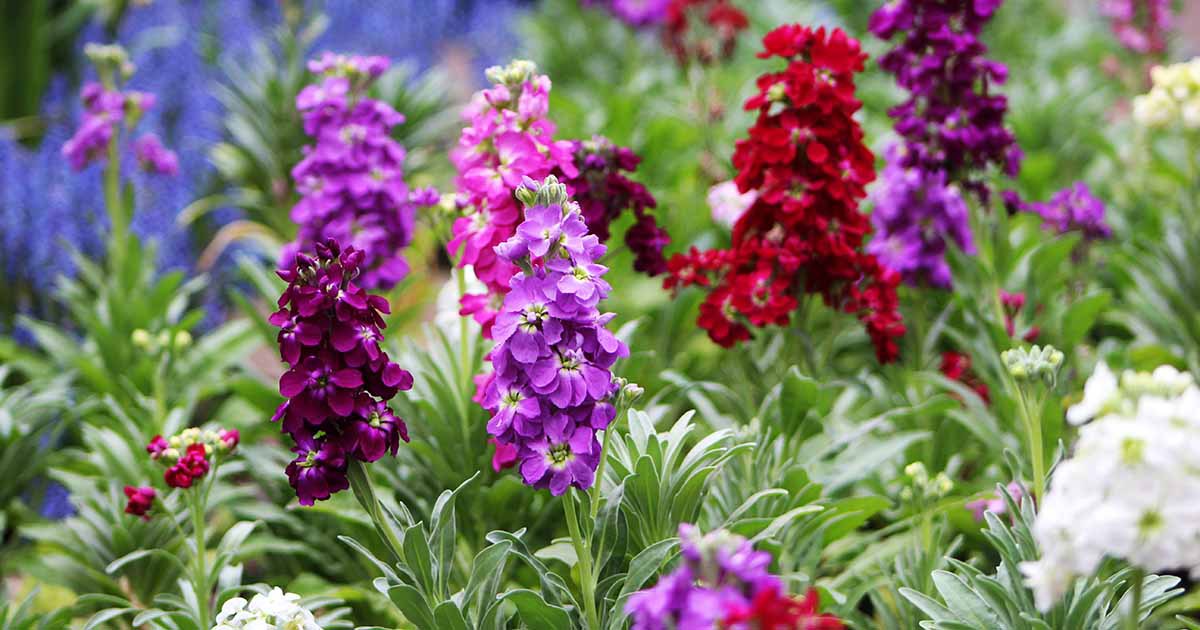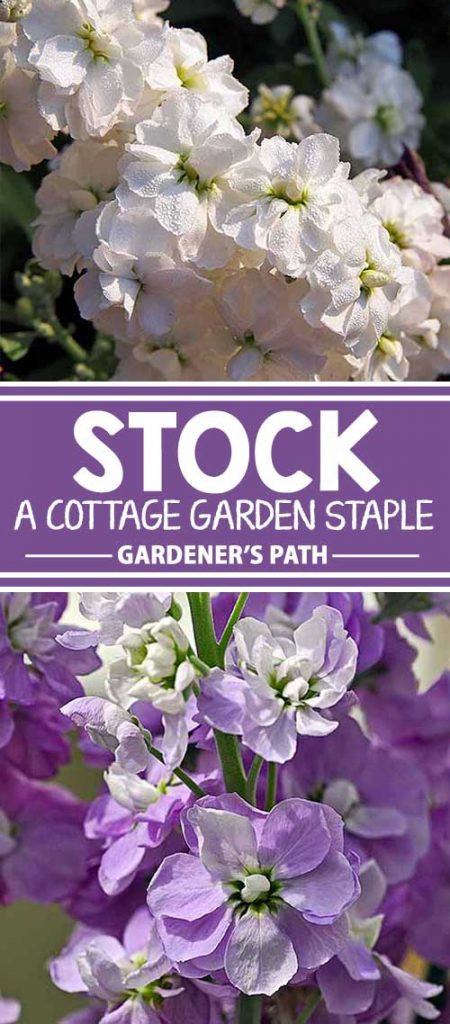In this article, we discuss all you need to grow your own stock flowers.
Here’s the lineup:
Let’s get growing!
Cultivation and History
M. incana is one of approximately 50 Matthiola species.
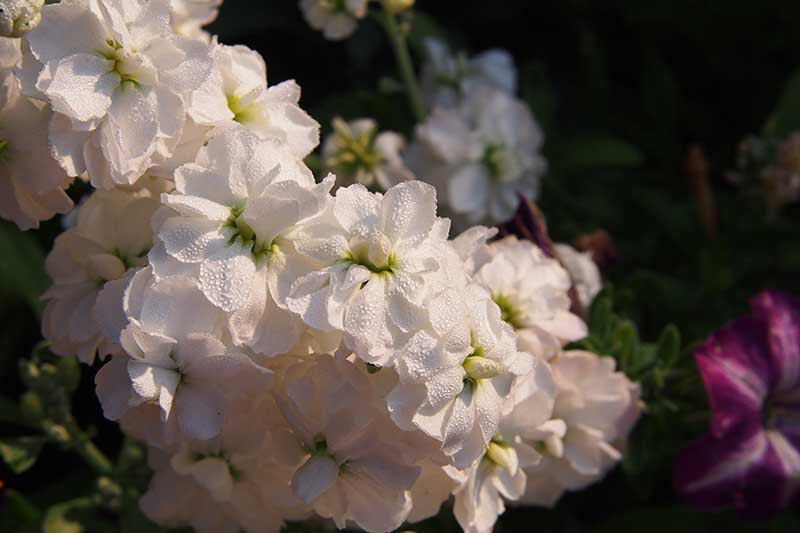
Also called gillyflower and ten-weeks, as well as hoary, Brompton, or vintage stock, the native species has been widely cultivated, and today’s varieties come in shades of apricot, lavender, pink, purple, red, white, yellow, and bicolor. There are many hybrid series of plants from which to choose.
Plant dimensions range from 12 to 36 inches tall, and nine to 18 inches wide. They are upright and may have one of two growth habits.
Columnar varieties have a single stem and a dense cluster of flowers.
Spray types are multi-stemmed with loose terminal blooms.
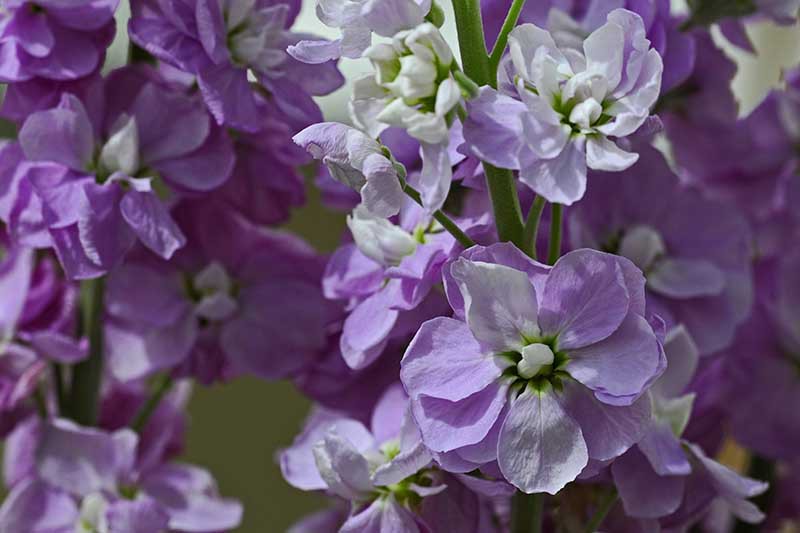
Like a snapdragon, the blossoms appear sequentially, from bottom to top, and sit above lush, somewhat hairy, grayish-green foliage.
The petals are arranged in either a single or double row, and have a spicy-sweet scent. The occurrence of single or double blossoms is random.
By chilling seedlings and examining their “cotyledons,” or seed leaves, professional breeders are often able to identify and thin out the single-petal types and retain the doubles, to bring the most robust blooms to market.
There are other Matthiola species, including M. longipetala. Visually, this plant pales in comparison, with its sparse, narrow petaled blooms. However, it makes up for its shortcomings by emitting a heady scent in the evening.
M. incana is a cool-weather plant that blooms from early spring into summer.
For buds to set, the temperature must be below 60°F.
Plants require full sun to light shade, and average to rich soil that drains well. The ideal pH is near neutral, or about 6.8 to 7.5.
M. incana is referred to as a half-hardy annual, short-lived perennial, or biennial.
How can this be?
In cool regions, it grows as an annual that may withstand a frost or two, hence the term “half-hardy.” Plants may thrive right through to fall in these locales.
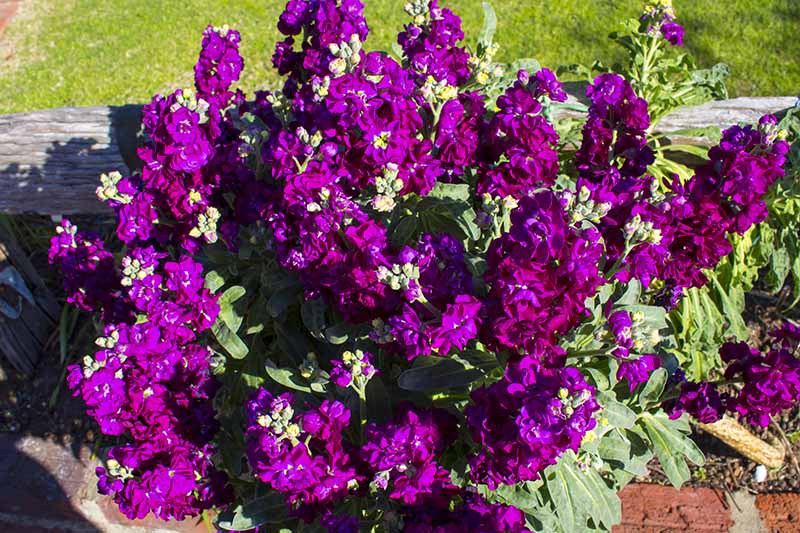
M. incana is a tender perennial In USDA Hardiness Zones 7 to 10 that may live for a few years, coming back with woodier stems each spring. Here, it blooms until the summer heat becomes oppressive.
The biennial characteristic refers to the tendency of perennial plants to bloom in the first year and set seed in the second year.
Stock is an odd name for a flower. It seems to be a reference to the “stocky” stems of perennial growth, and its use as an early-season garden filler.
Its Latin name is said to commemorate 16th-century herbalist Peter Matthioli (or perhaps Mattioli), personal physician to King Ferdinand I of Austria. A 1905 article titled “Memorial Plant Names,” in a Victorian-era British periodical called The Leisure Hour, refers to this likely origin.
It is believed that M. incana was imported by Thomas Jefferson and was growing in his Monticello gardens in 1771. And by Victorian times, it had become a delightful cottage garden staple.
Today, it’s cultivated commercially for both the floral industry and home garden planting.
Propagation
Start plants with seeds, divisions, or nursery seedlings.
From Seed
In Zones 7 to 10, pre-seed the garden or outdoor containers in the fall for early spring blooms.
In cool regions, start seeds indoors eight to 10 weeks before the last average spring frost date.
It is best to use individual seed starter cells for minimal disruption when transplanting to the garden.
Moisten the potting medium and press two seeds gently into each cell.
Barely cover the seeds with an eighth of an inch of soil, as they need light to germinate.
Maintain even moisture without oversaturation, by letting the cells almost dry out before watering again.
Place the cells in a sunny room with a temperature between 65 and 75°F.
The seeds should sprout within two weeks.
There are varieties of M. incana that have been bred to have a shorter growing season ranging from seven to 10 weeks – hence the nickname, “ten weeks.” Sow these directly outdoors in spring after the frost danger has passed. You’ll find some of the earliest blooming plants in the Cheerful and Cinderella series.
After the danger of frost has passed, gradually acclimate the seedlings to the outdoors for a few hours a day, and then transplant them to the garden or containers.
Place the seed starter cells level with the garden soil, to maintain the same planting depth.
If you are container gardening, choose pots that can accommodate their mature dimensions, plus an inch to fit in a hose nozzle or watering can spout.
When starting from seeds, expect it to take 10 to 12 weeks for them to reach maturity.
For plants to set buds, nighttime temperatures must not exceed 60°F, and they begin to decline once daytime temperatures climb to 80°F.
By Division
If you already grow perennials that come up yearly, divide existing plants to make new ones.
First, take note of how deep the plant is in the ground, because you will want to replicate this depth when you plant the divisions.
Dig your plants up at any time, slice down through the rootstock to make two or more, and transplant to new locations as desired.
From Seedlings/Transplanting
In both cool and warm regions, you can purchase nursery seedlings to transplant to the garden or containers as soon as they are available in early spring.
Plant at the same depth the seedlings are in their nursery pots. And if you’re container gardening, remember to accommodate the mature dimensions.
Why not experiment with seeds and plants and see what works best in your growing zone?
How to Grow
Find a location with full sun and average to moderately-rich, well-draining soil with a nearly neutral to slightly alkaline pH of 6.8 to 7.5
To determine the composition of the earth in your garden, conduct a soil test through your local agricultural extension.
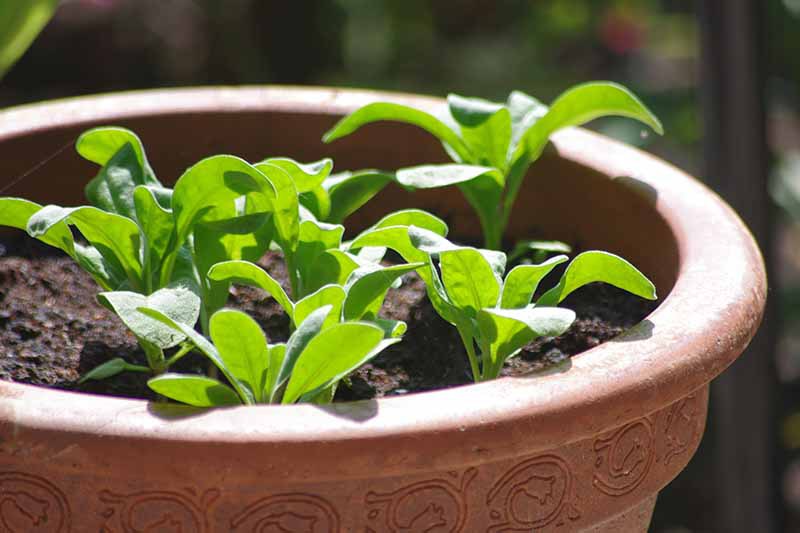
Work the soil to a depth of eight to 10 inches, until the large clods are broken up, and a smooth consistency is achieved.
Sprinkle a few seeds every nine to 18 inches, depending upon the mature dimensions of your plants. Barely cover them with 1/8 inch of fine soil.
Maintain even moisture during germination, but do not oversaturate.
When the seedlings have two sets of true leaves, thin them to one every nine to 18 inches.
Provide about an inch of water per week in the absence of rain. Take care to water the soil, and not the leaves, to inhibit fungal growth.
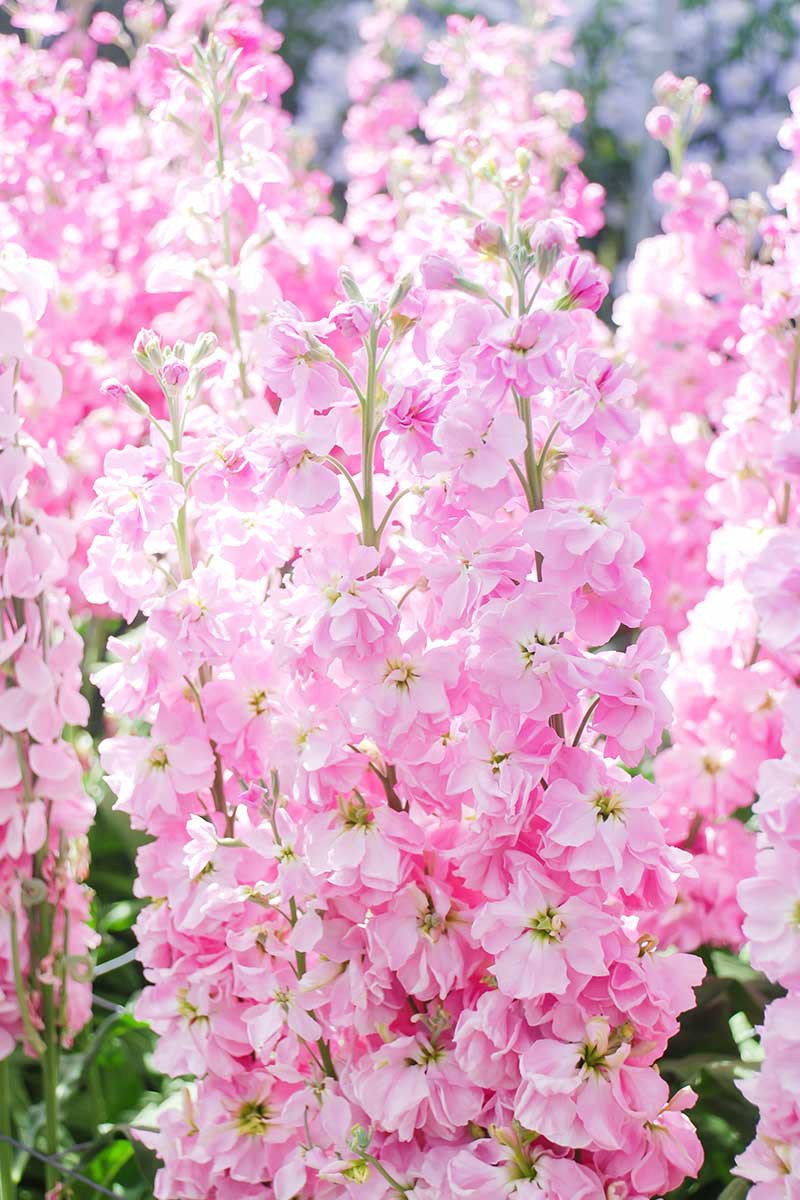
When the first buds appear, some people like to do what professional growers do, and pinch off the top inch or so of the budded growing tip for a more uniform, compact top.
If you garden in containers, consider the mature widths of the varieties you choose, and select pots with a diameter at least one inch larger, to allow room for watering. Standard pot depths are adequate.
And finally, if you are transplanting nursery seedlings, settle them into the ground so they are at the same depth they were in their starter pots.
Growing Tips
When planting, remember the following for best results:
- This is a cool-weather flower that needs to be planted early, because it declines with summer heat.
- Sow seeds shallowly, barely covering them with 1/8 inch of fine soil.
- Maintain even moisture during germination, then one inch per week. Avoid oversaturation.
- Pinch budding growing tips for more compact flower clusters.
Pruning and Maintenance
Weed the garden regularly to reduce competition for water, deter pests, and promote air circulation that inhibits fungal growth.
Add a two-inch layer of mulch for weed control, soil moisture retention, and ground cooling.
During the growing season, deadhead spent flower stems to their points of origin to maintain an attractive appearance. They are not likely to rebloom.
At season’s end, cut plants to the ground and remove the debris to inhibit the wintering over of pests and disease pathogens. Even perennials with woody stems should be maintained in this way.
Where to Buy
There are many cultivated varieties of M. incana from which to choose, ranging in height from 12 to 36 inches tall.
As you shop, you will find seeds and plants that have been bred for exceptional disease resistance, shortened days to maturity, and unusual colors and color combinations.
Imported seed packets often, but not always, include the phrase “phytosanitary certification” to guarantee that they are free of pests and diseases and meet the standards of the receiving country.
Here’s an attractive mix of dwarf seeds that you may like. ‘Midget’ is a dwarf variety that matures in 70 to 84 days.
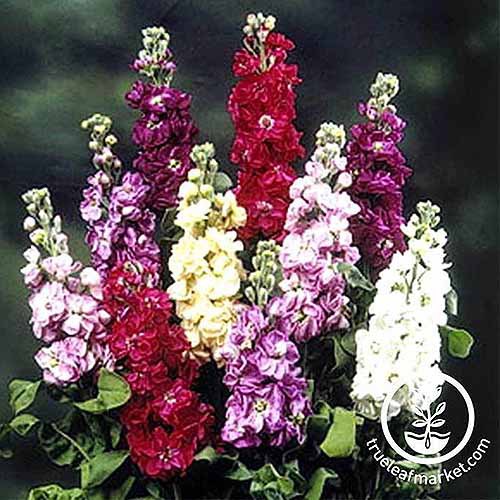
‘Midget’ Mix
Mature heights are eight to 12 inches tall, and you can expect between 60 to 80 percent of the seeds to produce double blossoms.
Find Midget Mix stock seeds from True Leaf Market in packages of 1,000 seeds, for flowers that range in color from purple to white.
Managing Pests and Disease
Quality plants and seeds that grow in conditions that suit them are the least likely to suffer the ravages of pests and disease.
However, sometimes trouble starts with extreme weather conditions, or an infestation or infection in a nearby plant.
Some pests to watch out for when cultivating stock are:
Aphids and cabbage white caterpillars suck the sap from plant tissue, and flea beetles chew it. Try handpicking, spraying with the hose, or treating plants with organic insecticidal neem oil to be rid of them.
Possible diseases that may affect plants include:
- Bacterial Blight
- Damping Off
- Fusarium Wilt
- Gray Mold
- Leaf Spot
- Root Rot
- Verticillium Wilt
- Wire Stem
These conditions are primarily fungal and may respond to fungicidal treatment. For small scale issues, snip off affected foliage, discard it in the trash, and sanitize your pruners afterwards.
Large scale infections may warrant the removal of plants from the garden and rotating to a new location next year.
Best Uses
From neutral to bold shades, the abundant, fragrant blooms of M. incana bring an aura of charm and romance to early-season settings.
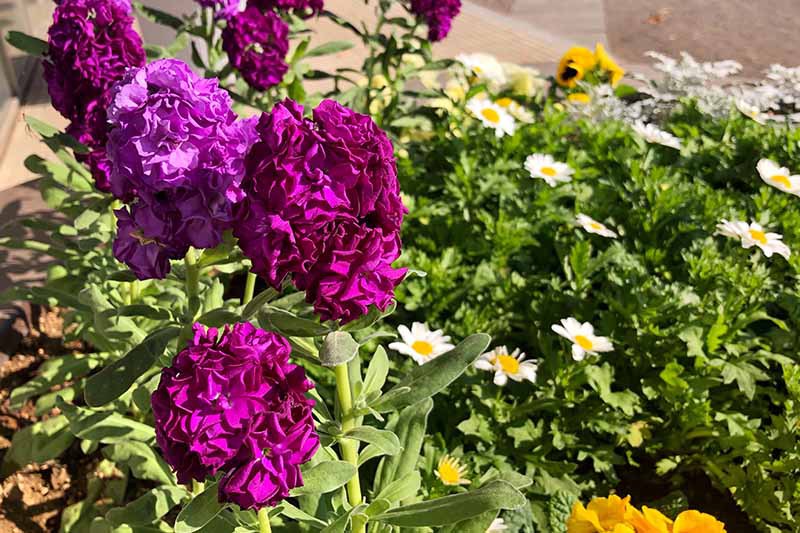
With heights ranging from 12 to 36 inches, there are options for front, middle, and rear placements in beds, borders, and container gardening arrangements.
Pair plants with cottage garden favorites like dianthus, heliotrope, iris, larkspur, pansy, petunia, and snapdragon that share similar cultural requirements.
Place them in a pot with calla lily and swan river daisy to highlight each specimen’s unique form.
Mix colors and plant en masse for a sweeping vista to rival the watercolors of the Impressionist masters.
You’re going to love having a ready supply of lush-blossomed cutting flowers when you introduce stock to your outdoor living space!
Did you know that you can keep vase arrangements looking and smelling fresh longer with two easy tips?
1. Remove leaves from the bottom portion of stems that will be under water.
2. Refresh vases daily by snipping the bottoms of all stems and changing the water.
This is especially important for M. incana, as it gets a cabbagey smell if the foliage begins to decompose in vase water. With good care, flowers should stay firm and fresh for at least a week.
Stock is not just another pretty face in the garden. It adds value to its surroundings by attracting bees and other types of beneficial insects, as well as butterflies and moths, that pollinate other plants like herbs and veggies.
In addition, birdwatchers are sure to enjoy watching a variety of avian species feast on the flower seeds at season’s end.
Quick Reference Growing Guide
| Plant Type: | Herbaceous flowering perennial (or annual depending on zone) | Flower / Foliage Color: | Bicolor, apricot, lavender, pink, purple, red, white, yellow/gray-green |
| Native to: | Southern Europe | Tolerance: | Deer, light shade |
| Hardiness (USDA Zone): | 7-10 | Soil Type: | Average to moderately fertile |
| Bloom Time: | Late spring to early summer | Soil pH: | 6.8-7.5 |
| Exposure: | Full sun | Soil Drainage: | Well-draining |
| Spacing: | 9-18 inches | Attracts: | Bees, birds, butterflies, moths, other beneficial insects |
| Planting Depth: | 1/8 inch (seeds) | Companion Planting: | Calla lily, dianthus, heliotrope, iris, larkspur, pansy, petunia, snapdragon, swan river daisy |
| Height: | 12-36 inches | Uses: | Beds, borders, containers, cottage gardens, cutting gardens, fragrant gardens |
| Spread: | 9-18 inches | Family: | Brassicaceae |
| Water Needs: | Moderate | Genus: | Matthiola |
| Maintenance | Low | Species: | Incana |
| Common Pests: | Aphids, cabbage white caterpillars, flea beetles | Common Diseases: | Fusarium wilt, gray mold, leaf spot, root rot, Verticillium wilt, wire stem |
Vibrant and Versatile
To recap, stock, or M. incana, does best in cool weather with full sun and moist, well-draining soil of average to moderately fertile quality.
Depending upon where you live, it may behave as a half-hardy annual, tender and short-lived perennial, or biennial.

Its sturdy, upright racemes add vertical interest to early-season gardens with a delightful palette of color-saturated blooms.
In addition to the varied hues, there are different sizes available that are well-suited to multiple garden placements.
It’s time to get out the garden planner. Be sure to add stock for armloads of blooms and the best vase arrangements you’ve ever made!
Does stock grow well where you live? Do you grow it as an annual or perennial? Tell us about your plants in the comments section below.
If you found this article informative and would like to read about more early-season flowers, we suggest the following:
About Nan Schiller
Nan Schiller is a writer with deep roots in the soil of southeastern Pennsylvania. Her background includes landscape and floral design, a BS in business from Villanova University, and a Certificate of Merit in floral design from Longwood Gardens. An advocate of organic gardening with native plants, she’s always got dirt under her nails and freckles on her nose. With wit and hopefully some wisdom, she shares what she’s learned and is always ready to dig into a new project!

